Brush Park: Difference between revisions
fix links |
|||
| Line 28: | Line 28: | ||
== History of Brush Park and Woodward East == |
== History of Brush Park and Woodward East == |
||
[[File:48 Edmund Detroit.JPG|left|thumb|House at 48 Edmund]] |
[[File:48 Edmund Detroit.JPG|left|thumb|House at 48 Edmund]] |
||
Beginning in the 1850s, entrepreneur Edmund Brush, son of the city's second mayor from its first incorporation, began developing his family's property, located conveniently close to downtown, into a neighborhood for Detroit's elite citizens.<ref name = BPHD>[http://www. |
Beginning in the 1850s, entrepreneur Edmund Brush, son of the city's second mayor from its first incorporation, began developing his family's property, located conveniently close to downtown, into a neighborhood for Detroit's elite citizens.<ref name = BPHD>[http://www.detroitmi.gov/historic/districts/brush_park.pdf Brush Park Historic District] from the City of Detroit</ref><ref name=Elmwood>[http://elmwoodhistoriccemetery.org/pages/brush.html Elijah Brush].''Elmwood Cemetery''.</ref> Homes were built in Brush Park beginning in the 1850s and peaking in the 1870s and 1880s; one of the [[Albert Kahn House|last homes built]] was constructed in 1906 by architect [[Albert Kahn (architect)|Albert Kahn]] for his personal use. Kahn lived in this home until his death in 1942, after which it was obtained by the [[Detroit Urban League]], which still uses it today. Other early residents of Brush Park included [[lumber baron]] [[David Whitney Jr.]], his daughter Grace Whitney Evans, [[Joseph L. Hudson]], founder of the eponymous department store, lumber baron Lucien Moore, banker Frederick Butler, merchant John P. Fiske, Dime Savings Bank founder William Livingston, and dry goods manufacturer Ransom Gillis. In the late 1800s, the Brush Park neighborhood became known as the "Little Paris of the Midwest."<ref name=MooreHouse/> |
||
Architects who designed these mansions included [[Henry T. Brush]], [[George D. Mason]], George W. Nettleton, and Albert Kahn.<ref name=Piligian>Piligian, Ellen (April 1, 2008).[http://www.modeldmedia.com/features/mcmillin13708.aspx McMillin's Detroit].''Model D media''. Retrieved on July 24, 2009.</ref> The [[Neo-Renaissance|French Renaissance]] style William Livingston House (1892-93) at 294 Elliot was Albert Kahn's first commission. Livingston founded the Dime Savings Bank. The William Livingston House was commemorated in a painting by Lowell Bioleau entitled ''Open House'' which was unveiled the day of its demolition September 15, 2007, underscoring preservationist efforts.<ref name=openhouse>[http://atdetroit.net/ Open House]. Retrieved on September 26, 2009.</ref> |
Architects who designed these mansions included [[Henry T. Brush]], [[George D. Mason]], George W. Nettleton, and Albert Kahn.<ref name=Piligian>Piligian, Ellen (April 1, 2008).[http://www.modeldmedia.com/features/mcmillin13708.aspx McMillin's Detroit].''Model D media''. Retrieved on July 24, 2009.</ref> The [[Neo-Renaissance|French Renaissance]] style William Livingston House (1892-93) at 294 Elliot was Albert Kahn's first commission. Livingston founded the Dime Savings Bank. The William Livingston House was commemorated in a painting by Lowell Bioleau entitled ''Open House'' which was unveiled the day of its demolition September 15, 2007, underscoring preservationist efforts.<ref name=openhouse>[http://atdetroit.net/ Open House]. Retrieved on September 26, 2009.</ref> |
||
| Line 62: | Line 62: | ||
|[[Italianate]] |
|[[Italianate]] |
||
| |
| |
||
|This house is a relatively rare example of residential Italianate architecture in Detroit.<ref name = "cochrane">[http://www. |
|This house is a relatively rare example of residential Italianate architecture in Detroit.<ref name = "cochrane">[http://www.detroitmi.gov/historic/districts/cochrane_hse.pdf Lyman Cochrane House] from the city of Detroit, retrieved 9/7/09</ref> It was originally built for eye doctor John Terry, but in 1871 was sold to Judge Lyman Cochrane.<ref name = "cochrane2">[http://www.detroit1701.org/LymanCochraneHouse.html Lyman Cochrane House] from Detroit1701, retrieved 9/7/09</ref> Cochrane was a state senator and Superior Court Judge, serving in this capacity until his death in 1879. |
||
|- |
|- |
||
|John P. Fiske House |
|John P. Fiske House |
||
| Line 70: | Line 70: | ||
|Victorian |
|Victorian |
||
| |
| |
||
|John P. Fiske, was a Detroit merchant of china and crockery.<ref name = "fiske">[http://www. |
|John P. Fiske, was a Detroit merchant of china and crockery.<ref name = "fiske">[http://www.detroitmi.gov/historic/districts/fiske_hse.pdf John P. Fiske House] from the city of Detroit, retrieved 9/7/09</ref> The house is within the Woodward East Historic District. |
||
|- |
|- |
||
|Ransom Gillis House |
|Ransom Gillis House |
||
| Line 110: | Line 110: | ||
|[[Neo-Renaissance|English Renaissance]] |
|[[Neo-Renaissance|English Renaissance]] |
||
|Albert Kahn |
|Albert Kahn |
||
|In 1906, architect [[Albert Kahn (architect)|Albert Kahn]] built a home for his personal use.<ref name = "kshn1">[http://www. |
|In 1906, architect [[Albert Kahn (architect)|Albert Kahn]] built a home for his personal use.<ref name = "kshn1">[http://www.detroitmi.gov/historic/districts/kahn_hse.pdf Albert Kahn House] from the city of Detroit</ref> He lived in the home from 1906 until his death in 1942.<ref name = "kahn2">[http://www.detroit1701.org/Albert%20Kahn%20Home.html Albert Kahn Home] from Detroit1701.org</ref> The house is listed on the [[National Register of Historic Places]].<ref name=NationalRegisterWayne/> |
||
|- |
|- |
||
|George Ladve House |
|George Ladve House |
||
| Line 150: | Line 150: | ||
|[[Neo-Renaissance|French Renaissance]], [[Second Empire (architecture)|Second Empire]] |
|[[Neo-Renaissance|French Renaissance]], [[Second Empire (architecture)|Second Empire]] |
||
|Unknown |
|Unknown |
||
|The French Renaissance, Second Empire style, Elisha Taylor House with its [[mansard roof]] was built for William H. Craig, a Detroit land speculator.<ref name = "taylor">[http://www. |
|The French Renaissance, Second Empire style, Elisha Taylor House with its [[mansard roof]] was built for William H. Craig, a Detroit land speculator.<ref name = "taylor">[http://www.detroitmi.gov/historic/districts/taylor_hse.pdf Elisha Taylor House] from the city of Detroit</ref> In 1875,<ref name = "taylor2">[http://www.detroit1701.org/ElishaTaylorHome.html The Elisha Taylor Home] from Detroit1701.org</ref> Craig sold the house to attorney Elisha Taylor.<ref name = "taylor"/> Taylor was a Detroit attorney who held many offices during his career, including City Attorney,<ref name = "taylor"/> assistant Michigan Attorney General from 1837 to 1841, and Circuit Court Commissioner from 1846 to 1854.<ref name = "taylor2"/> The house is listed on the [[National Register of Historic Places]].<ref name=NationalRegisterWayne/> |
||
|- |
|- |
||
|Joseph F. Weber House |
|Joseph F. Weber House |
||
| Line 158: | Line 158: | ||
|[[Georgian architecture|Georgian]] |
|[[Georgian architecture|Georgian]] |
||
| |
| |
||
|Originally owned by lumber baron Joseph F. Weber, 206 Eliot is a Georgian style house.<ref name = "weber">http://www. |
|Originally owned by lumber baron Joseph F. Weber, 206 Eliot is a Georgian style house.<ref name = "weber">http://www.detroitmi.gov/historic/districts/weber_hse.pdf Weber House] from the city of Detroit</ref> |
||
|- |
|- |
||
|Detroit Society of Arts and Crafts |
|Detroit Society of Arts and Crafts |
||
Revision as of 12:15, 13 May 2010
Woodward East Historic District | |
 Streetscape on Edmund | |
| Location | Detroit, Michigan |
|---|---|
| Architectural style | Late Victorian, Second Empire, Other |
| NRHP reference No. | 75000973[1] |
| Added to NRHP | January 21, 1975 |
Brush Park Historic District is a 24 block neighborhood in Detroit, Michigan.[2][3] It is bounded by Mack on the north, Woodward Avenue on the west, Beaubien on the east, and the Fisher freeway on the south. The neighborhood is experiencing restorations of its historic Gilded Age Victorian style homes and luring new residents.[4][5] This neighborhood is within the larger area known as Midtown.
Woodward East Historic District
The Woodward East Historic District is a smaller historic district, recognized by the National Register of Historic Places, which is completely encompassed by the larger Brush Park neighborhood. The Woodward East Historic District is located on Alfred, Edmund, and Watson Streets from Brush Street to John R Street in Detroit, Michigan. Woodward East is particularly known for the High Victorian style residences constructed Detroit's wealthiest citizens. Although many of the once-grand houses have been demolished in recent years, those remaining exhibit a variety of Victorian style subtypes[6] and architectural details, including Second Empire slate Mansard roofs, Romanesque columns and classical dentiled cornices.[7]
History of Brush Park and Woodward East

Beginning in the 1850s, entrepreneur Edmund Brush, son of the city's second mayor from its first incorporation, began developing his family's property, located conveniently close to downtown, into a neighborhood for Detroit's elite citizens.[2][8] Homes were built in Brush Park beginning in the 1850s and peaking in the 1870s and 1880s; one of the last homes built was constructed in 1906 by architect Albert Kahn for his personal use. Kahn lived in this home until his death in 1942, after which it was obtained by the Detroit Urban League, which still uses it today. Other early residents of Brush Park included lumber baron David Whitney Jr., his daughter Grace Whitney Evans, Joseph L. Hudson, founder of the eponymous department store, lumber baron Lucien Moore, banker Frederick Butler, merchant John P. Fiske, Dime Savings Bank founder William Livingston, and dry goods manufacturer Ransom Gillis. In the late 1800s, the Brush Park neighborhood became known as the "Little Paris of the Midwest."[9]
Architects who designed these mansions included Henry T. Brush, George D. Mason, George W. Nettleton, and Albert Kahn.[10] The French Renaissance style William Livingston House (1892-93) at 294 Elliot was Albert Kahn's first commission. Livingston founded the Dime Savings Bank. The William Livingston House was commemorated in a painting by Lowell Bioleau entitled Open House which was unveiled the day of its demolition September 15, 2007, underscoring preservationist efforts.[11]

During the 19th century, around 300 homes were built in Brush Park, including 70 Victorian mansions. However, the neighborhood began to decline in the late 19th and early 20th century, when the advent of streetcars and then automobiles allowed prosperous citizens to live further from downtown. Early residents moved out, notably to up-and-coming neighborhoods such as Indian Village and Boston-Edison, and the neighborhood became less fashionable. During the Great Depression, many of the old mansions were subdivided into apartments, and as demand for housing fell after World War II, the homes were abandoned and fell into disrepair. As of 2001, about 154 original structures remained in the area.
Brush Park's revival began in the 1990s and has accelerated recently. A number of the older mansions have been restored, and more have been stabilized. In addition, new condominiums have been built in the southern part of Brush Park, near the Fisher Freeway. [12] Brush Park Historic District's general boundaries are Woodward Avenue, Mack, Beaubien, and the Fisher Freeway.
Historic structures
| Name[13] | Image | Year | Location | Style | Architect | Notes |
|---|---|---|---|---|---|---|
| Frederick Butler House | 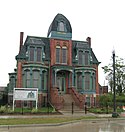
|
1882 | 291 Edmund Pl. | French Renaissance, Second Empire | Built in 1882, the Frederick Butler House at 291 Edmund Place is a French Renaissance Second Empire style mansion with a Mansard roof which was restored in 2006 and contains 8,400 sq. ft.[14] It is located near Edmund Pl. and Brush St. within the Woodward East Historic District. The original ownwer, Frederick Butler was a banker.[14] | |
| Lyman Cochrane House | 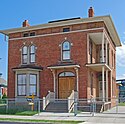
|
1870 | 216 Winder | Italianate | This house is a relatively rare example of residential Italianate architecture in Detroit.[15] It was originally built for eye doctor John Terry, but in 1871 was sold to Judge Lyman Cochrane.[16] Cochrane was a state senator and Superior Court Judge, serving in this capacity until his death in 1879. | |
| John P. Fiske House | 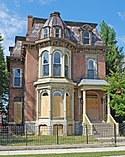
|
1876 | 261 Edmund Pl. | Victorian | John P. Fiske, was a Detroit merchant of china and crockery.[17] The house is within the Woodward East Historic District. | |
| Ransom Gillis House | 
|
1876 | 205 Alfred and John R. | Victorian | Brush & Mason | This house has been heavily documented by documentarian Camilo José Vergara.[18] The house is within the Woodward East Historic District |
| John Harvey House | 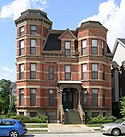
|
1887 | 97 Winder St. | Victorian | John V. Smith | John Harvey was a pharmacist and philanthropist. The house contains 11,000 square feet, eight marble fireplaces, and three-story staircase. The current owners purchased the John Harvey House in 1986, renovated the structure, and, in 2005, opened it as a 10-room guesthouse.[19] The house is listed on the National Register of Historic Places.[20] |
| Bernard Ginsburg House | 
|
1898 | 236 Adelaide St. | Tudor Revival | Albert Kahn | Bernard Ginsburg was an important figure in philanthropy, civic service, and the Jewish community in Detroit during the late 19th and early 20th century.[21] .[7] He commissioned architect Albert Kahn to design this house, one of Kahn's earliest works. Kahn went on to become well-known in industrial and commercial architecture; the Ginsburg house and its English Renaissance style exhibited is typical of Kahn's early work.[21] The house is listed on the National Register of Historic Places.[20] |
| Hudson-Evans House | 
|
1872 | 79 Alfred St. | Italianate, Second Empire | Unknown | Also known as the Joseph Lothian Hudson House or the Grace Whitney Evans House. The house was a gift from David Whitney Jr. to his daughter Grace upon her marriage to John Evans in 1872. It later became the J.L. Hudson family residence. Listed on the National Register of Historic Places.[20] |
| Albert Kahn House | 
|
1906 | 208 Mack Ave. | English Renaissance | Albert Kahn | In 1906, architect Albert Kahn built a home for his personal use.[22] He lived in the home from 1906 until his death in 1942.[23] The house is listed on the National Register of Historic Places.[20] |
| George Ladve House | 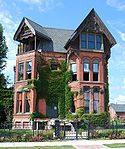
|
1882 | 269 Edmund Pl. | Eastlake Victorian | Originally owned by George Ladve, 269 Edmund Pl., an Eastlake Victorian style mansion built in 1882 and restored in 2008, contains 7,400 sq. ft. Ladve had owned a carpet and upholstery company. In the late 1890s, the Frohlich family added a music room. Frohlich was among the original philanthropists to the Detroit Symphony Orchestra.[24] | |
| Perry McAdow House | 1893 | 4605 Cass Ave. | ||||
| Lucien Moore House | 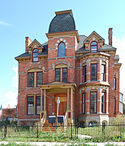
|
1885 | 104 Edmund Pl. | French Renaissance, Gothic Revival | Originally owned by lumber baron Lucien Moore, 104 Edmund Place, a French Renaissance Gothic Revival style mansion restored in 2006, has 7,000 sq. ft.[14][25]The Lucien Moore House restoration was featured December 27, 2005 by HGTV's restore America Initiative in partnership with the National Trust for Historic Preservation.[9][26] | |
| Emanual Schloss House | 1870 | 284 Winder | Emanuel Schloss was a dry goods merchant and haberdasher in Detroit.[27] In 1870, he built one of the best examples of a Second Empire home that still exists in Detroit.[27] The home has been restored and now operates as the 234 Winder Street Inn.[28] | |||
| Elisha Taylor House | 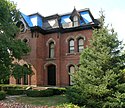
|
1870 | 59 Alfred | French Renaissance, Second Empire | Unknown | The French Renaissance, Second Empire style, Elisha Taylor House with its mansard roof was built for William H. Craig, a Detroit land speculator.[29] In 1875,[30] Craig sold the house to attorney Elisha Taylor.[29] Taylor was a Detroit attorney who held many offices during his career, including City Attorney,[29] assistant Michigan Attorney General from 1837 to 1841, and Circuit Court Commissioner from 1846 to 1854.[30] The house is listed on the National Register of Historic Places.[20] |
| Joseph F. Weber House | 1901 | 206 Eliot | Georgian | Originally owned by lumber baron Joseph F. Weber, 206 Eliot is a Georgian style house.[31] | ||
| Detroit Society of Arts and Crafts | 47 Watson | |||||
| First Unitarian Church of Detroit | 
|
1890 | 2870 Woodward Ave. at Edmund | Donaldson and Meier | Richardsonian Romanesque | This church was dedicated in November, 1890.[32] The congregation used the church until 1936, when the widening of Woodward Avenue required a remodelling of the church. The church is listed on the National Register of Historic Places.[20] |
| First Presbyterian Church | 
|
1889 | 2930 Woodward Ave. | Richardsonian Romanesque | George D. Mason | George D. Mason modeled the First Presbyterian Church after Henry Hobson Richardson's Trinity Church in Boston.[33] When Woodward was widened in 1936, the elaborately-carved entrance porch was moved from the Woodward facade to the Edmund Place side.[33] The church is listed on the National Register of Historic Places.[20] |
| Bonstelle Theatre | 
|
1902 | 3424 Woodward Ave. | Beaux Arts | Albert Kahn, C. Howard Crane | When Rabbi Leo M. Franklin first began leading services of Detroit's Temple Beth El in 1899, he felt that the construction of a new temple building on Detroit's "Piety Row" stretch of Woodward would increase the visibility and prestige on Detroit's Jewish community.[34] Groundbreaking began on November 25, 1901, with the ceremonial cornerstone laid on April 23, 1902.[35] The structure is listed on the National Register of Historic Places.[20] |
Education
Brush Park is within the Detroit Public Schools district. Residents are zoned to Spain Elementary School for K-8,[36][37] while they are zoned to Martin Luther King High School (9-12) for high school.[38]
References

- ^ "National Register Information System". National Register of Historic Places. National Park Service. 2008-04-15.
- ^ a b Brush Park Historic District from the City of Detroit
- ^ Mullen, Ann, (January 3, 2001).Brush Park and hope. Metro Times. Retrieved on June 14, 2008.
- ^ Pfeffer, Jaime, (September 12, 2006).Falling for Bush Park. Metro Times. Retrieved on June 14, 2008.
- ^ Archambault, Dennis (February 14, 2006).Forging Bush Park. Metro Times. Retrieved on June 14, 2008.
- ^ DETROIT HISTORIC DISTRICTS from CityScape Detroit
- ^ a b Woodward East Historic District from the state of Michigan
- ^ Elijah Brush.Elmwood Cemetery.
- ^ a b National Trust for Historic Preservation (December 27, 2005).Detroit’s Lucien Moore House Honored by HGTV.Retrieved on May 3, 2009.
- ^ Piligian, Ellen (April 1, 2008).McMillin's Detroit.Model D media. Retrieved on July 24, 2009.
- ^ Open House. Retrieved on September 26, 2009.
- ^ Dennis Archambault, "Forging Brush Park," 2/14/06
- ^ Historic sites online.Michigan Historic Preservation Office. Retrieved on December 11, 2007.
- ^ a b c Pfeffer, Jaime (September 12, 2006).Falling for Brush Park.Model D Media. Retrieved on September 26, 2009.
- ^ Lyman Cochrane House from the city of Detroit, retrieved 9/7/09
- ^ Lyman Cochrane House from Detroit1701, retrieved 9/7/09
- ^ John P. Fiske House from the city of Detroit, retrieved 9/7/09
- ^ Ransom Gyllis Home from Detroit1701.org, retrieved 9/7/09
- ^ The Largest Historic Mansion in Detroit's Brush Park Area Opens as a New, Prestigious Bed and Breakfast Inn (press release)
- ^ a b c d e f g h National Register of Historic Places - Michigan: Wayne County. National Park Service. Retrieved on July 27, 2009.
- ^ a b Bernard Ginsburg House from the state of Michigan
- ^ Albert Kahn House from the city of Detroit
- ^ Albert Kahn Home from Detroit1701.org
- ^ Crain's Detroit House Party.Crain's Detroit Business. Retrieved on September 27, 2009.
- ^ Lucien Moore House, Detroit1701.org. Retrieved on September 26, 2009.
- ^ Foster, Margaret (May-June 2005).Rebuilding Begins at Home: HGTV, Trust to focus on housing for Restore America's third year.Preservation Magazine. National Trust for Historic Preservation. Retrieved on September 27, 2009.
- ^ a b Emanuel Schloss House/234 Winder Street Inn from Detroit1701.org
- ^ 234 Winder Street Inn home page
- ^ a b c Elisha Taylor House from the city of Detroit
- ^ a b The Elisha Taylor Home from Detroit1701.org
- ^ http://www.detroitmi.gov/historic/districts/weber_hse.pdf Weber House] from the city of Detroit
- ^ First Unitarian Church of Detroit from State of Michigan.
- ^ a b First Presbyterian Church from Detroit1701.org.
- ^ Temple Beth-El from Detroit 1701.org.
- ^ Katz, Irving I., The Beth El Story (with a History of Jews in Michigan Before 1850), Wayne State University Press, 1955, pp. 96-101.
- ^ "Elementary School Boundary Map." Detroit Public Schools. Retrieved on October 20, 2009.
- ^ "Middle School Boundary Map." Detroit Public Schools. Retrieved on October 20, 2009.
- ^ "High School Boundary Map." Detroit Public Schools. Retrieved on October 20, 2009.




